Navajo Twill Weave Double Saddle Blanket [SOLD]
+ Add to my watchlist Forward to Friend
- Category: Navajo Textiles
- Origin: Diné of the Navajo Nation
- Medium: wool
- Size: 51” x 33”
- Item # C4502M SOLD
This twill weave, double saddle blanket was woven from white, black, and brown sheep’s wool after shearing, cleaning, carding, spinning, and laboriously setting up on an upright loom. Twill weave textiles generally are made only for saddle blankets, although they are serviceable as floor rugs as well. Twill weaves are sturdier than tapestry weaves, making them quite suitable for use as saddle blankets.
“Predominant in Pueblo textiles from the days of the Anasazi through recent times, the various twill-weave techniques were rarely used by Navajo weavers after 1800 but made a brief resurgence in popularity in the 1870s, particularly in the weaving of saddle throws and women’s mantas.”
Twill weave saddle blankets are still occasionally made by the Diné, both for their own use and for sale. This double saddle blanket does not show any evidence of having been used on a horse, so it must have been one that was made to be sold.

Warp and Weft: "All twill weaves are produced by floating the weft elements over more than one warp at a time to create a raised pattern of color and texture. Three twill-weave techniques were used by both Navajo and Pueblo weavers: plain twill forming diagonal floats; herringbone twill, in which the diagonal floats alternate direction to form a vertical zigzag or chevron pattern; and a diamond twill, in which the herringbone patterns are woven in such a manner as to create concentric diamond patterns."
Condition: very good condition
Provenance: this Navajo Twill Weave Double Saddle Blanket is from the collection of a gentleman from California
Reference: Alice Kaufman and Christopher Selser. The Navajo Weaving Tradition: 1650 to the Present
TAGS: textiles, Navajo Nation

- Category: Navajo Textiles
- Origin: Diné of the Navajo Nation
- Medium: wool
- Size: 51” x 33”
- Item # C4502M SOLD



